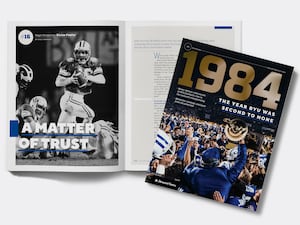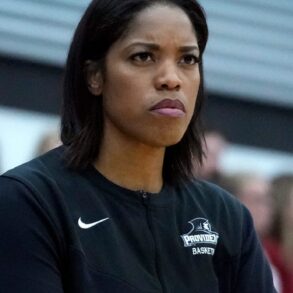There have been plenty of times Utah, BYU, Utah State, Weber State and Southern Utah have been national leaders in free-throw shooting. It’s a skill that shouldn’t be taken for granted.
Right now, all of them are, well, struggling at the line.
I called an expert on free-throw shooting over the weekend to pick his brain on what was done back in his day to produce elite free-throw shooting teams.

Special Collector’s Issue: “1984: The Year BYU was Second to None”
Get an inclusive look inside BYU Football’s 1984 National Championship season.
Former BYU and SUU coach Roger Reid has benefited from many seasons with teams that led the nation in free-throw percentage. That he did it at both BYU and SUU proves that there was something to his methods.
Of course, it helps to have naturally talented free-throw shooters to work with, like Michael Smith, who was among national leaders in the skill when he played college ball.
Smith currently holds the BYU school record for free-throw shooting percentage in a season — .925 in the 1988-89 season. Smith also comes in at No. 3 on the list for his .904 percentage in 1986-87.
Utah teams struggling with free throws
So far this season, college teams in Utah have been horrible at free-throw shooting.
Wisconsin leads the nation at 85.09%, according to NCAA data.
Compare that to Southern Utah, which comes in at 132nd with 73.13% free-throw shooting, or Utah State, which is No. 175 with 71.84%.
Weber State is next at No. 247 (69.46%) and then comes BYU, which is No. 263 at 69.03%.
Utah Valley is just behind BYU at No. 264. The team makes 68.98% of its free throws.
It’s followed by Utah Tech at No. 312 (66.47%) and Utah at No. 342 with 63.84% accuracy.
Back in the day, Reid’s BYU teams made an impressive 77.3% of free throws in 1995, 76.7% in 1993 and 76.5% in 1996.
In 1989, the last LaDell Andersen team — which was ranked as high as No. 3 at 17-0 — made 527 of 647 free throws for 81.5% on the season.
Coach Roger Reid’s free throw system
Reid believed that making free throws in the final minutes of close games was the most important factor in determining wins and losses. He told his players it was imperative that they excelled at that part of the game, that it was a priority, even a passion that needed tending and work.
It’s both mechanical and mental and it takes confidence and a lot of labor. There are no shortcuts.
Reid remembers that when his son, Randy, was a ninth grader, his friend, former UCLA coach Jim Herrick, asked Randy how many free throws he made in 500 tries.
“I can make 450 out of 500,” replied Randy.
“That’s not 500,” said Herrick, who told him he would call back the next week and he wanted him to make 500.
Randy got up at 6 a.m. every morning and shot free throws with a goal of making 500. It was a situation where if he missed one, he had to start over.
“It puts pressure on you,” said the father. “You learn to make them under pressure because a miss means you start again.”
Reid asked his college players to do the 500. Not all could do it, but it was a goal. He believed that if you looked at the rim that many times a day, it would bleed off into your regular game and shots because you’d get used to seeing the rim and it would be wired to your brain as an automatic pathway with shotmaking.
When he coached at BYU, Reid required every player to shoot 100 free throws a day and chart how many they made and turn it in. The goal was to make 90%.
In the locker room, he had the charts posted for the team to see. It was a matter of being accountable.
“This isn’t just about putting the ball through the hoop; it’s about understanding the mental and physical components that make or break a player’s performance at the line. Games are won and lost by one point, and it boils down to who makes free throws,” Reid said.
Free-throw shooting takes strategy, psychology and relentless practice, he said. Practicing created discipline that translates into game situations.
The first day of season practice wasn’t about dribbling or shooting off the dribble, rebounding or passing — it was all about free throws.
Reid would lecture the team: “The most important thing we’re going to do to win games is shoot free throws and make them, especially when it boils down to the last two minutes of the game.”
Throughout practice, after a taxing part of drills, Reid would stop and pair up players two-by-two to shoot free throws. With heart rates high and sweat visible, he’d put them at the line.
Each player would shoot 10 and have to make 90%. If they missed one of the 10, they’d have to run a lap around the court and return as their partner tried for his 10 of 10.
Reid said in a game a player who shot 80% would be left alone. “I wouldn’t bother them,” he said. A player who failed to make 80% in a game or 90% in practice would get Reid’s attention with mechanics drills.
Also, during practice he would line the entire team up at the free-throw line and players would have to make free throws on demand. If a guy missed, the entire team would have to run laps.
That, he said, created pressure and made a player perform and concentrate, a desire for perfection under pressure.
“Every player took their free throws seriously,” he said.
As far as the mechanics, Reid said free-throw shooting has to be a routine and it has to be simple. Players who brought the ball up over their head, moved it all around and shot were creating problems for their shot.
“It is important not to short-arm the shot,” he said.
He required players to shoot and follow through with their wrists until the ball landed on the hardwoods.
When lining up a shot, he didn’t care if you took one, two or three dribbles, but while aiming, you had to look at the front of the rim and see an imaginary line from the ball to the rim and maintain a short, compact stroke akin to a baseball swing.
Reid required every player to have a repeatable process that could be relied upon in any game situation, ensuring consistency over comfort.
In BYU’s loss at home to Texas Tech last week, the Cougars made just 12 of 21 free throws. Many of those were the front end of one-and-ones.
“This is where championships are won — at the line,” said Reid. “This is where close games, not those blowouts, are won and lost.”
This post was originally published on this site be sure to check out more of their content.








